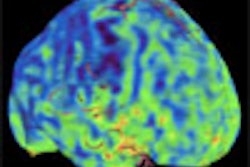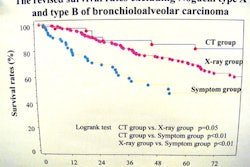Most patients who underwent MR colonography (MRC) and optical colonoscopy preferred MRI, according to a new study by researchers from Essen, Germany, and Atlanta, GA. When the patients were questioned about which colorectal screening test they'd rather have in the future, however, MR's advantage dwindled.
The goal of creating a more palatable exam is at least as important in Germany as it is in the U.S. In that country even free screening optical colonoscopy has failed to draw the large numbers of participants that will be needed to reduce the incidence of colorectal cancer among aging adults.
"Only moderate participation is observed in screening programs, even if access to OC (optical colonoscopy) was free. This has motivated investigators to develop and evaluate alternative strategies to assess the colon," wrote study authors Drs. Sonja Kinner, Christiane Kuehle, Jost Langhorst, and colleagues from Kliniken Essen-Mitte in Essen, Germany, and Dr. Thomas Lauenstein from Emory University in Atlanta (European Radiology, May 24, 2007).
Bowel cleansing has long been reported to be the most unpleasant part of colorectal cancer screening, both for virtual colonoscopy (VC) or conventional (optical) colonoscopy, the group noted. For the study they hypothesized that new reduced prep VC without ionizing radiation would improve patient acceptance vis-a-vis conventional colonoscopy.
"Beyond diagnostic accuracy, patients' acceptance mainly will determine the impact of MRC as a screening examination," Kinner and her colleagues wrote. "However, most investigations so far have focused on preference evaluation, comparing (CT colonography) to OC. Furthermore, mainly patients at high risk or with suspected colonic disease were enrolled in those trials. To determine the true value of a screening tool, it needs to be investigated within a screening population."
The researchers approached members of a national health insurance program with an offer to volunteer for dual-modality screening. In all 455 of 727 (62.7%) individuals 50 years and older responded, while 284 asymptomatic individuals (141 men and 143 women; mean age 59 years, range 50-82) were included in the study.
All participants underwent MRC and colonography within four weeks' time. MRC was based on fecal tagging, while complete bowel purgation was used for conventional colonoscopy.
The MRC fecal tagging preparation consisted of a solution ingested in 250-mL portions with meals for 48 hours before imaging. The solution consisted of 5% Gastrografin (Schering, Berlin), 1% barium (Polibar, E-Z-EM, Lake Success, New York), and 2% locust bean gum. Volunteers were encouraged to drink plenty of fluids, but otherwise faced no dietary restrictions. Before imaging, the colon was distended with approximately 2 L of body-temperature tap water using hydrostatic pressure of 1 m. Patients were also given a spasmolytic agent intravenously, either 40 mg of scopolamine (Buscopan, Boehringer Ingelheim, Ingelheim, Germany) or 1 mg glucagon hydrochloride (GlucaGen, Novo Nordisk, Mainz, Germany).
MRI, performed on a 1.5-tesla Magnetom Sonata scanner (Siemens Medical Solutions, Erlangen, Germany), was based on the acquisition of TrueFISP images and T2-weighted gradient-echo images, acquired both before and after Gd-DOTA contrast administration (1 mmol/kg of body weight, Dotarem, Guerbet, France). Colonography took about 20 minutes, and patients had to retain the enema for about 12 minutes, which was uneventful except for minor spills in two patients.
Experienced gastroenterologists performed conventional colonoscopy between six and 28 days (average 19.2 days) after MRI, using standard equipment (CFQ 140, Olympus, Tokyo). Patients drank a 3-L solution of GoLytely (Braintree Laboratories, Braintree, MA) the evening before the exam, and sedatives and analgesics were also routinely administered before the procedure, the group reported.
The participants were asked to complete questionnaires 24 hours after the procedure to avoid the possibility of interference with the sedatives used in MRC.
Overall, their perceptions of OC versus MRC were not statistically different (p = 0.096). On a scale of 1 to10, with 10 being the worst experience, the mean acceptance values were 3.0 for OC and 3.4 for MRC, the authors reported.
Patients younger than 55 scored MRC worse than OC (mean 4.3 versus 3.5, p = 0.009), while those 55 and older reported little difference in the acceptance of both exams (OC: 3.0, MRC: 3.1, p = 0.388).
Acceptance of bowel purgation versus fecal tagging varied widely (4.8 versus 3.4, respectively; p = 0.001), and again the younger patients were less accepting of purgation than the older patient group (5.6 versus 4.8, respectively). Fecal tagging received better marks among both younger (4.2) and older (3.1) patients, respectively. A statistically significant preference was found for both younger and older patients for placement of a rectal tube versus the endoscope (4.0 versus 2.7, p < 0.001, respectively), the authors wrote.
Preference for MRC did not extend significantly to future exams, however. Of 284 participants, 124 (44%) preferred OC for future exams, while 133 (46%) preferred MRC. And while 243 (86%) subjects preferred MRC for future exams, 39 patients (14%) refused to consider the procedure in the future.
"This paper carries three messages we believe to be important," Kinner and her colleagues wrote. "First, patients' acceptance of OC and MRC within a screening population is not statistically significantly different. Similarly, distribution of preference for future examinations is almost identical. Secondly, there are specific aspects of these procedures considered most unpleasant, namely the bowel preparation prior to OC and the placement of the rectal tube before MRC. Finally, there are evident differences depending on patients' ages: subjects of an older patient group scored both modalities, as well as single examination steps, with considerably better marks compared to younger participants."
MRC may become an attractive screening alternative, particularly among patients who decline conventional colonoscopy screening, they concluded.
By Eric Barnes
AuntMinnie.com staff writer
June 6, 2007
Related Reading
Colonoscopy declines at VA: Is limited capacity to blame? November 13, 2006
Study pits CT against MRI for virtual colonoscopy, August 23, 2006
Minimal-prep VC preferred over colonoscopy, February 23, 2005
VC antispasmodics show mixed distension results, real patient-acceptance gains, August 27, 2004
Men more likely than women to accept bowel cancer screening, February 25, 2006
Copyright © 2007 AuntMinnie.com



















